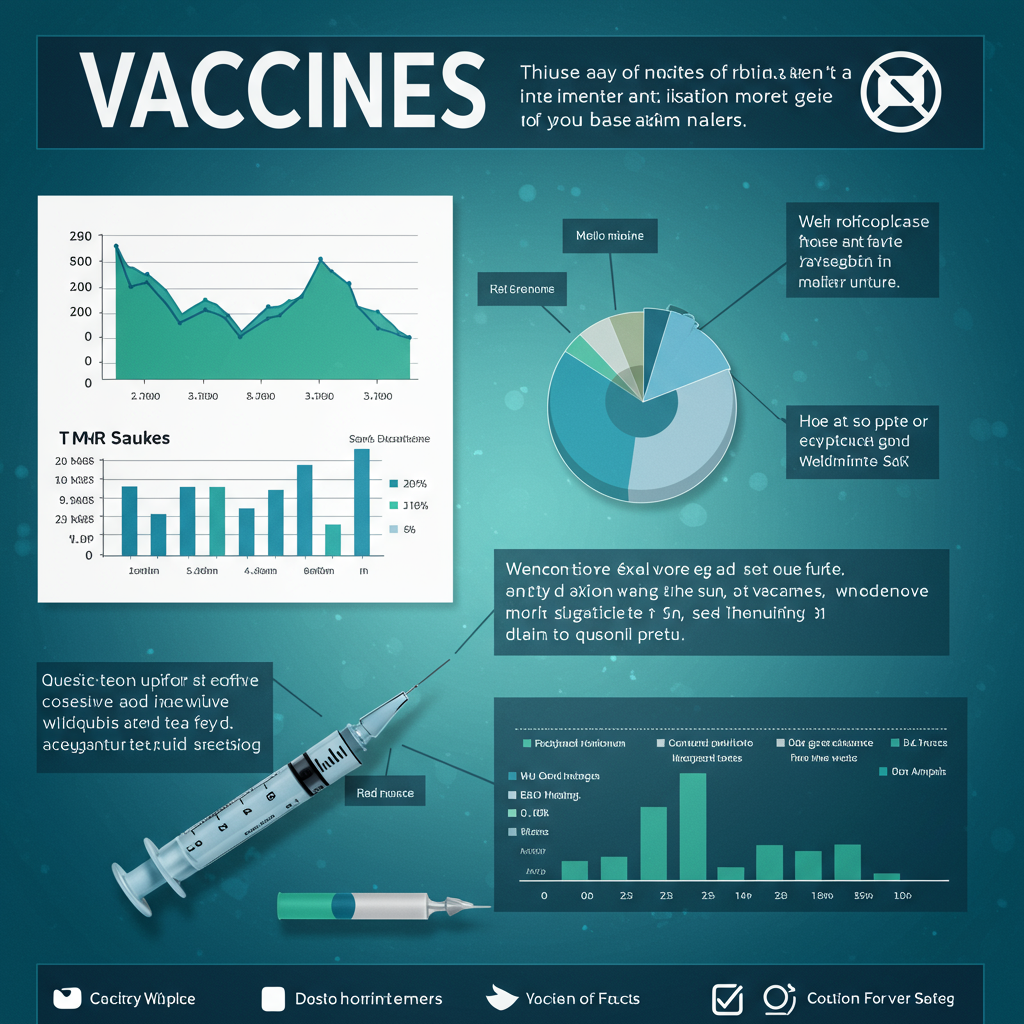Misinformation about vaccines poses a significant challenge to public health worldwide. Despite overwhelming scientific evidence supporting their safety and effectiveness, persistent myths continue to circulate, leading to vaccine hesitancy and preventable outbreaks of serious diseases. Understanding the science behind vaccines and dispelling these common misconceptions is crucial for protecting individual health and community well-being. This article addresses six prevalent claims about vaccines, presenting clear, science-backed facts to counter the spread of harmful untruths.
Separating Fact from Fiction: Addressing Common Vaccine Claims
Vaccines stand as one of modern medicine’s most remarkable achievements, rigorously tested and monitored tools that have eradicated diseases and saved millions of lives. Yet, doubts fueled by misinformation persist. Let’s examine the science behind some of the most frequent claims.
Claim 1: Vaccine Ingredients Like Mercury or Thimerosal Are Harmful
A common concern revolves around ingredients, particularly Thimerosal. Thimerosal is a mercury-based preservative. It was previously used in multi-dose vaccine vials. Its purpose was to prevent dangerous bacterial or fungal contamination after the vial was opened.
Thimerosal contains ethylmercury. This compound is different from methylmercury. Methylmercury is the toxic type found in some fish. Ethylmercury is quickly processed and eliminated by the body. It does not build up to harmful levels. Due to public concern, Thimerosal has been removed from most U.S. vaccines since 2001. Some multi-dose flu vaccines still contain it. Extensive scientific studies have consistently found no evidence of harm from Thimerosal at the trace amounts used in vaccines. Its removal was a precautionary measure, not because it was proven unsafe.
Claim 2: Vaccines Cause Autism
This damaging myth originated from a single 1998 study. The study, led by Andrew Wakefield, has been widely discredited. It was formally retracted due to serious procedural errors, undisclosed conflicts of interest, and falsified data. Subsequent large-scale scientific investigations across multiple countries have conclusively shown no link between vaccines and autism spectrum disorder.
These studies have involved hundreds of thousands of children. They looked at various vaccines and different vaccination schedules. The consistent finding is that vaccines do not cause autism. The timing of childhood vaccinations often coincides with the age when autism symptoms might first be noticed. This overlap in timing is a correlation. It is not a cause-and-effect relationship. Autism is a complex neurological condition with genetic and environmental factors. Scientific consensus is clear: vaccines are not a cause.
Claim 3: COVID-19 Vaccines Cause Cancer
Rumors linking COVID-19 vaccines to cancer, sometimes termed “turbo cancer,” lack any scientific basis. The primary COVID-19 vaccines utilize messenger RNA (mRNA) technology. mRNA delivers instructions to cells to make a harmless piece of the virus’s spike protein. This triggers an immune response.
mRNA from vaccines cannot enter the cell’s nucleus. The nucleus is where our DNA is stored. Therefore, mRNA cannot alter human DNA. The vaccine’s mRNA is fragile and breaks down quickly in the body. Similarly, claims about SV40 fragments causing cancer from vaccines are unfounded. There is no scientific evidence connecting any approved COVID-19 vaccine to an increased risk of cancer. mRNA is also a natural substance found in many foods and is digested harmlessly.
Claim 4: Governments Exaggerate Disease Threats to Push Vaccines
Vaccines have dramatically reduced the burden of infectious diseases worldwide. Their success is a testament to their effectiveness. Vaccines are estimated to have saved approximately 154 million lives over the last 50 years. Diseases once feared, like smallpox, which killed about 30% of those infected, have been eradicated globally thanks to vaccination campaigns. Polio, another devastating disease, is now on the brink of eradication.
Public health strategies, including vaccination programs, are developed based on extensive scientific research and data. They are guided by expert bodies like the Centers for Disease Control and Prevention (CDC) and the World Health Organization (WHO). These strategies are aimed at protecting populations from infectious diseases. When vaccination rates fall, these diseases return. Recent measles outbreaks in unvaccinated communities are a stark reminder of this reality. Public health guidelines are rooted in decades of collected evidence, not political agendas.
Claim 5: Homeopathy and Supplements Can Replace Vaccines
Some alternative health practices promote homeopathy or dietary supplements as alternatives to vaccination. However, scientific evidence does not support these claims. Vaccines work by introducing a weakened or inactive form of a pathogen, or components of it, to the body. This safely trains the immune system to recognize and fight off the actual disease.
Homeopathic remedies are based on extreme dilutions. They contain little to no active ingredient. Supplements might support general health. They do not specifically trigger the targeted immune response needed to prevent specific infectious diseases like measles or polio. Major health organizations and even most professional homeopathy bodies recommend vaccination as the primary and effective means of protection against infectious diseases. Relying on unproven alternatives leaves individuals vulnerable to serious, preventable illnesses.
Claim 6: Healthy Children Are at Higher Risk of Dying from Infections If Not Vaccinated
It’s a dangerous misconception that healthy children are naturally immune or face minimal risk from vaccine-preventable diseases. While some children may experience milder symptoms, others, even those previously healthy, can suffer severe complications or death. Before the measles vaccine became widely available in the U.S. in 1963, hundreds of children died from measles each year. Widespread vaccination led to a over 99% reduction in measles deaths.
Diseases like measles can cause pneumonia, encephalitis (brain swelling), and a rare, fatal neurological condition called subacute sclerosing panencephalitis (SSPE) years later. Polio can cause permanent paralysis. Whooping cough can be deadly for infants. These are not benign childhood inconveniences. Vaccination significantly reduces the risk of contracting these diseases and suffering severe outcomes, even for seemingly healthy children. Data from recent outbreaks shows that unvaccinated individuals, regardless of prior health status, are the most vulnerable. This claim is unequivocally false.
The Real Consequences of Vaccine Misinformation
The spread of false information about vaccines has tangible and tragic results. As of June 2025, the United States saw three deaths from measles this year alone. This number surpasses the total measles deaths in the entire previous decade combined. These deaths are a direct consequence of declining vaccination rates and the reintroduction of measles into under-vaccinated communities.
Beyond fatalities, vaccine-preventable diseases can cause long-term health issues. Children who contract measles face risks of complications, including potentially devastating brain inflammation later in life. Such outcomes underscore the critical importance of relying on credible health information and following science-backed recommendations.
Vaccines undergo rigorous testing, multiple levels of review by health authorities, and continuous monitoring for safety and effectiveness. They are among the safest and most impactful public health interventions ever developed. They prevent suffering and save lives on a massive scale. If you have questions or concerns about vaccines, the most reliable source of information is a trusted healthcare provider – a doctor, nurse, or pharmacist. Do not rely on social media, anecdotal stories, or non-expert websites. Choosing vaccination protects not just you and your children, but also vulnerable individuals in your community who cannot be vaccinated due to age or medical conditions.
Frequently Asked Questions
How is vaccine safety ensured before they are given to the public?
Vaccine safety is a multi-step process involving extensive research and clinical trials before approval. After approval, they are continuously monitored. This includes several phases of clinical trials involving thousands of participants to test for safety and efficacy. Regulatory bodies like the FDA in the U.S. review all data before licensing a vaccine. Post-market surveillance systems, such as the Vaccine Adverse Event Reporting System (VAERS) and the Vaccine Safety Datalink (VSD), actively track any potential issues after a vaccine is in use.
If most people are vaccinated, why is it still important for my child to get vaccinated?
While high vaccination rates create herd immunity, which protects vulnerable individuals, this protection weakens when rates decline. Unvaccinated individuals remain susceptible and can contract and spread diseases, even to those who are vaccinated (though breakthrough infections are usually milder) or those who cannot be vaccinated. Maintaining high individual vaccination coverage is crucial to sustaining herd immunity and preventing outbreaks that put infants, the elderly, and those with weakened immune systems at serious risk.
Where are the best places to find accurate, science-based information about vaccines and immunization schedules?
Reliable information about vaccines should come from trusted public health organizations and healthcare professionals. Excellent resources include the Centers for Disease Control and Prevention (CDC) website, the World Health Organization (WHO) website, and the official websites of national health ministries or departments. Your pediatrician, family doctor, or local public health clinic are also invaluable sources for personalized advice based on your health history and local disease prevalence.
Word Count Check: ~1150 words




